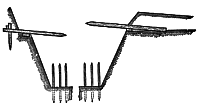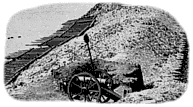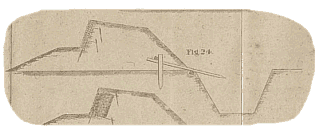 A fraise was an obstacle consisting of palisades
projecting horizontally from the scarp or counterscarp of a temporary
fortification's ditch. When positioned on the scarp it was designed to inhibit
attacking troops who had already entered a work's ditch from scaling the
scarp to reach the parapet. When positioned just below the crest of the
counterscarp it was designed to make it more difficult for attacking troops
to enter the ditch or escape from it if their attack failed. This type of
obstacle was generally only applied to well developed semi-permanent works
since it had to be constructed in unison with the raising of the parapet
(thus increasing the amount of time and labor required to construct the parapet)
and could only be employed in relatively wide and deep A fraise was an obstacle consisting of palisades
projecting horizontally from the scarp or counterscarp of a temporary
fortification's ditch. When positioned on the scarp it was designed to inhibit
attacking troops who had already entered a work's ditch from scaling the
scarp to reach the parapet. When positioned just below the crest of the
counterscarp it was designed to make it more difficult for attacking troops
to enter the ditch or escape from it if their attack failed. This type of
obstacle was generally only applied to well developed semi-permanent works
since it had to be constructed in unison with the raising of the parapet
(thus increasing the amount of time and labor required to construct the parapet)
and could only be employed in relatively wide and deep
 ditches. Palisades composing a fraise could not extend beyond
the foot of a ditch's scarp to prevent attacking troops from using it as
shelter against heavy stones, logs, or large shells rolled into the ditch
by the defenders and the ends of the palisades had to be at least seven feet
above the bottom of the ditch to place them out of easy reach of troops trapped
in the ditch. An interval of 12 feet had to be left between the extremities
of the palisades and the opposite side of the ditch to prevent attacking
troops from using ladders or planks to bridge the interval. ditches. Palisades composing a fraise could not extend beyond
the foot of a ditch's scarp to prevent attacking troops from using it as
shelter against heavy stones, logs, or large shells rolled into the ditch
by the defenders and the ends of the palisades had to be at least seven feet
above the bottom of the ditch to place them out of easy reach of troops trapped
in the ditch. An interval of 12 feet had to be left between the extremities
of the palisades and the opposite side of the ditch to prevent attacking
troops from using ladders or planks to bridge the interval.
 Fraises were constructed as soon as the ditch had
been excavated to a sufficient depth and the mound of the parapet raised
high enough to give the fraise's palisades a slight downward angle. Cushions
consisting of 4 inch scantling were laid on the parapet mound about 4 to
5 feet from and parallel to the crest of the scarp. Palisades were then laid
on and spiked to these cushions at intervals of 6 to 12 inches. A riband
was then laid on and spiked down onto the upper surfaces of the palisades
to fix them into place. Once the fraise had been laid excavation of the ditch
resumed and the rear section of the palisades buried under the body of the
parapet. Fraises were constructed as soon as the ditch had
been excavated to a sufficient depth and the mound of the parapet raised
high enough to give the fraise's palisades a slight downward angle. Cushions
consisting of 4 inch scantling were laid on the parapet mound about 4 to
5 feet from and parallel to the crest of the scarp. Palisades were then laid
on and spiked to these cushions at intervals of 6 to 12 inches. A riband
was then laid on and spiked down onto the upper surfaces of the palisades
to fix them into place. Once the fraise had been laid excavation of the ditch
resumed and the rear section of the palisades buried under the body of the
parapet. |